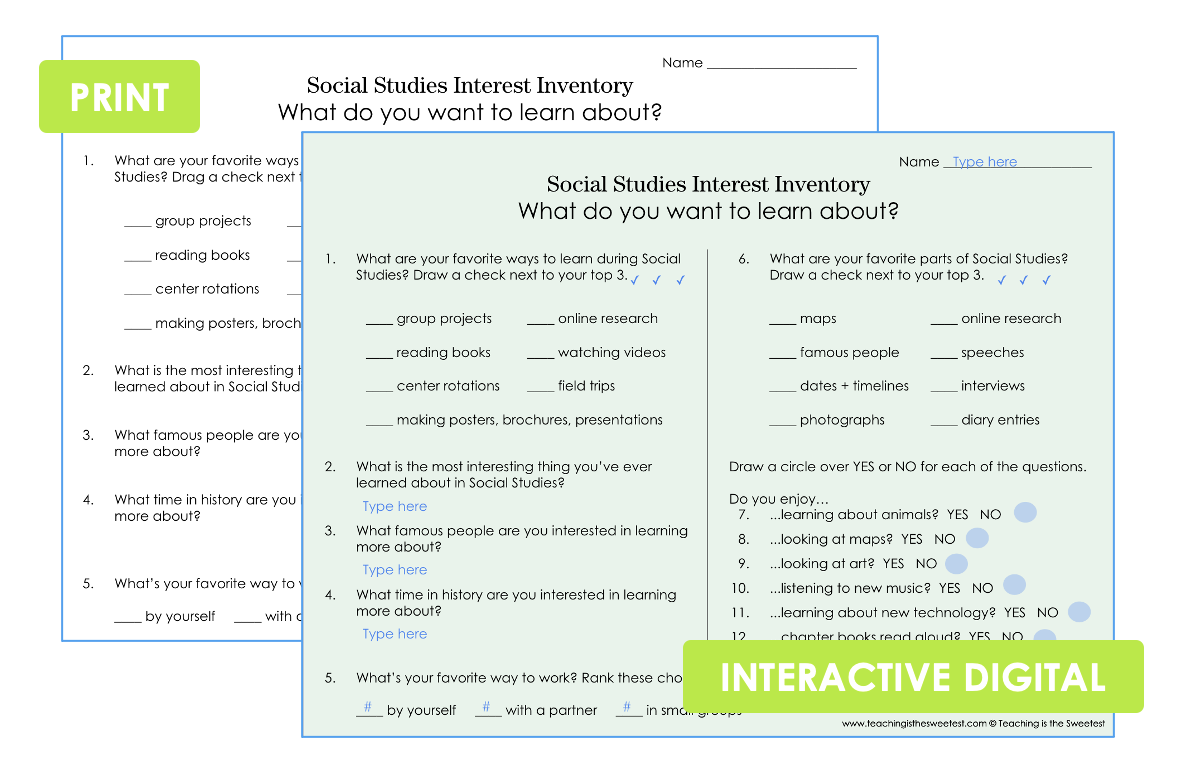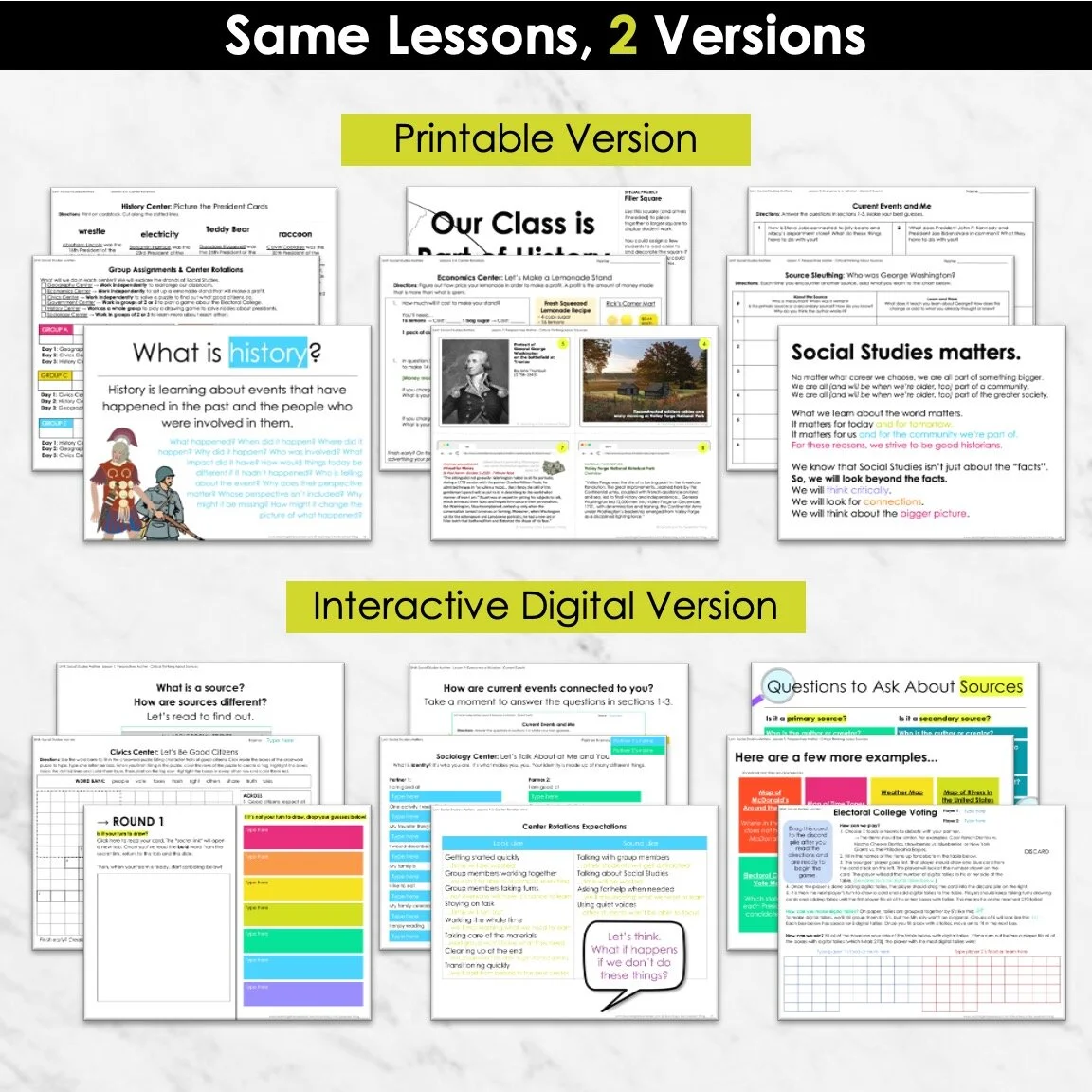8 Simple Ways to Make Social Studies Lessons More Interesting
So you want to make your Social Studies lessons interesting?
Maybe you hated Social Studies when you were in school.
Maybe you still do.
Maybe you love Social Studies, but the majority of your students hate it.
I’m here to tell you that Social Studies does not have to be boring for you OR for your students.
I’m going to share 8 ideas for engaging Social Studies lessons that you can use In your classroom TODAY.
1. Take Inventory
Find out what students are actually interested in, and use that as a starting point.
Have your students fill out a questionnaire at the beginning of the year (but really it’s never too late to do) that gathers information about what they love to learn about, how they like to learn, and more!
Grab a free Social Studies interest inventory below that can be printed or used digitally.
2. Engage All Learning Styles
And see how many of the five senses you can tackle while you’re at it!
Move beyond the textbook to include visuals, music, and movement when possible. Here are some ideas to get your wheels turning:
What photographs can you find? Bonus points if they’re primary sources! If you study the Cold War, for example, UNC has a collection of primary source images that are organized by topic.
Can you include drawings, such as political cartoons or portraits? The Library of Congress, which is always a helpful resource, has a collection of political cartoons covering the time period surrounding World War I.
How can you incorporate art? Consider creating an art museum or presentation with images of art that are relevant to the topic or time period you’re studying. Take the Civil War, for instance. The Smithsonian American Art Museum has a beautiful collection of carefully curated pieces created by artists from the time period that show how they perceived things in America at the time.
During the morning as students are entering the classroom, play music from a playlist created by artists during the time period. If you’re studying World War II, artists like Frank Sinatra and Sarah Vaughn were a hit. Did you also know that “war songs” were popular during this time?
Are there any important speeches that you could share with students? For example, during your Civil Rights Movement unit or while highlighting Black History, you could share with students Dr. Martin Luther King, Jr.’s "I Have a Dream" speech.
As a class, learn a new dance that is connected to the culture or time period you’re studying. If you’re studying the Roaring 20’s, teach your students the popular Charleston dance. This exercise is also a great classroom community builder!
Is there something that you could create a hands-on model of? If you’re studying geography, you could make a 3D map with sculptures. If you’re learning about Westward Expansion and the Oregon Trail, students could make covered wagons. (Side note: this could be a great STEM project idea!)
What can you bake or bring in for students to taste test? Of course, you need to be mindful of food allergies, but food can really bring things to life. If you’re learning about World War I, have your students try hardtack, which were cost-effective and long-lasting biscuits eaten by soldiers. This recipe shared by the Australian War Memorial is pretty simple.
3. Connect with Literature
Good stories bring history to life.
Students (and adults alike) LOVE stories. Stories really do bring so many concepts to life. There are so many golden historical fiction read alouds and chapter books that can bring what may seem like boring topics to life for students.
Each time you begin a new unit, begin a new historical read-aloud that pairs with the concept or time period of focus. Find a time during your instructional day that you can dedicate a few minutes to reading it aloud. For example, it could be the way you open your Social Studies lesson each day or what you have students do at the end of the day while waiting to be dismissed.
For each unit of study, grab as many books (fiction and nonfiction) from your school library and the local library. You’ll likely find librarians willing to help connect you with books related to the topic you’re studying. Keep all of the books you find in the front of your classroom in an easily accessible basket throughout the study.
4. Get Technology Involved
Going digital and paperless can make learning about the past feel fresh.
Not to mention, thanks to the Quarantine of 2020, there are also now more high-quality digital tools for learning than ever. Museums, universities, libraries, and many more organizations from all over have incredible libraries of student-friendly and engaging content available digitally. In many cases, it’s all totally FREE.
This interactive map of the building of the transcontinental railroad is a great example of one of the many free digital tools available on the web for kids.
You can check out the lists I’ve put together and organized by topic here!
5. Make It Personal
Your students will care more when what they’re learning about hits close to home.
It won’t come as news to you that students are most interested in things that are most impactful and connected to their own lives. Ask yourself the question: how can I connect what we’re learning about most directly to my students?
If you’re focused on map skills, use Google Maps or Google Earth to find the distance between your class’ favorite celebrities’ houses. Have students create a map of the school or their neighborhood.
If you’re learning about Native American heritage, contact the Native nation located nearest to your school. Have a member of the nation come to class to share or find books about the nation.
If you’re learning about the American Revolutionary War, find the battle sites that are most closely located to your school.
6. Find the Funny, Weird, and Surprising
It goes without saying that your students love giggling, being grossed out, and the “shock and awe” effect of learning something unexpected.
Certainly, not all parts of Social Studies should be taken lightly, but there are some topics that allow for it. A quick Google search will easily connect you with an endless supply of fun facts. (Just make sure you stick with reputable sources, of course.)
Let’s say for example you’re going to teach a unit on the United States government. By searching “funny facts about United States Presidents”, I came across National Geographic Kid’s U.S. Presidential Fun Facts list. Like did you know that President Jimmy Carter was a peanut farmer before he took a job at the White House?
7. Keep It Real
Use primary sources to give the facts to students straight from the sources.
In a world of filters and layers of truth, what better way to equip your students than to draw them in with primary sources that are as raw as it gets? Primary sources come straight from the source, and your students (just like any adults you interact with) will appreciate the unfiltered truths that come from studying primary sources.
8. Bridge the Past with the Present
Help your students see why yesterday matters for today and tomorrow. Help them see why what’s happening across the world matters to where they’re standing right now.
One of the reasons students are often least interested in Social Studies class is because they feel that it, especially history, is not relevant to their lives. If you know anything about Social Studies, you know this is FAR from true. Everything that is happening in the world right now is happening because of something that happened before in history, so your job is to help students find those connections!
If you’re looking for a deeper dive into bridging the past with the present to make your Social Studies lessons interesting and meaningful, this unit has everything you need to do just that. It’s perfect for the beginning of the year when you head back to school, but it truly can be used anytime during the year as a way to refocus and reshape student mindsets.








